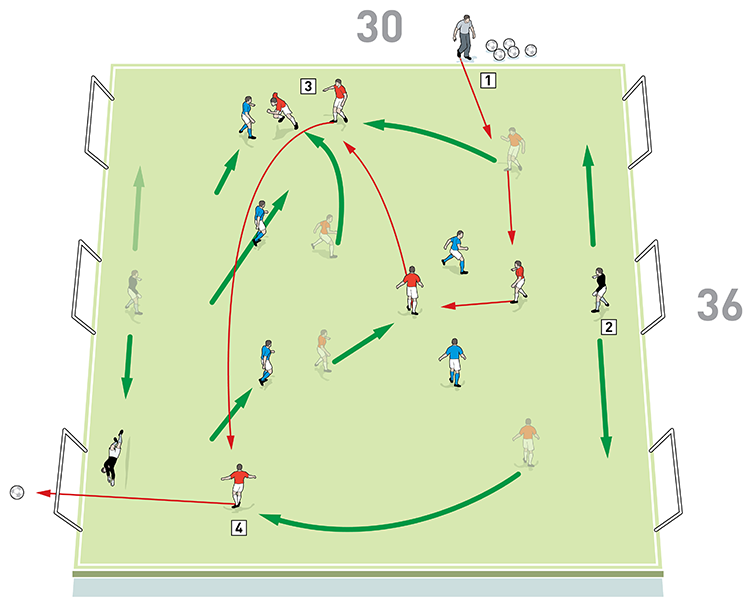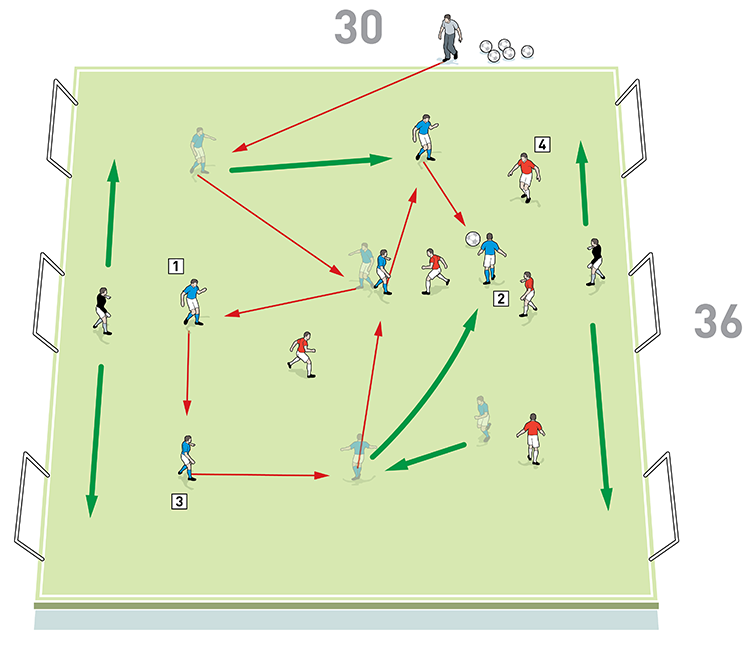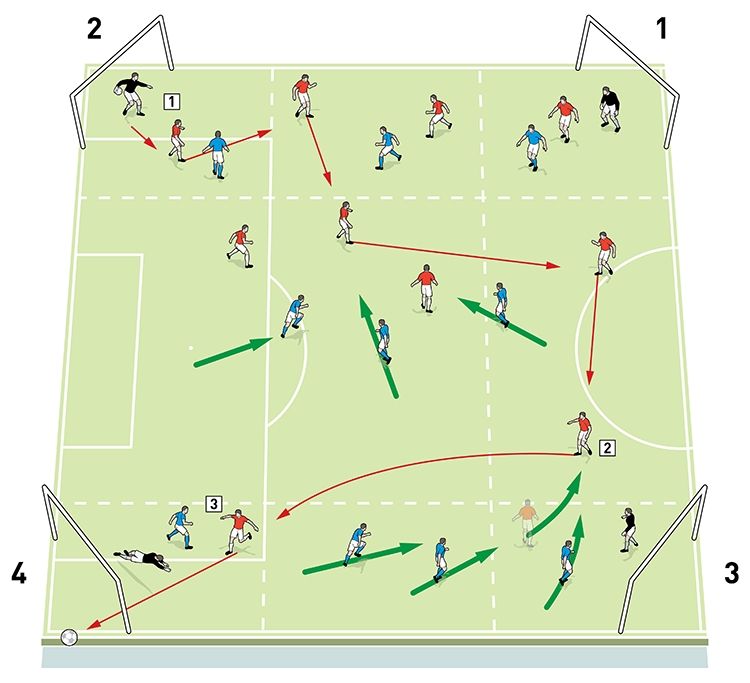Switching play and creating wide overloads
This is a possession session and it’s focused on switching play to create overloads in wide areas. It is designed so that players have to make decisions on when and how to switch play. It also works on the tactical demands on the players to create overloads once the ball comes across the pitch.

| Area | Up to half a pitch |
| Equipment | Balls, bibs, cones, 6 mini goals, 4 full size goals |
| No. of Players | Up to 20 players + 4 goalkeepers |
| Session Time |
5v5 possession: 20mins, Four goals: 60mins |
This is a possession session and it’s focused on switching play to create overloads in wide areas. It is designed so that players have to make decisions on when and how to switch play. It also works on the tactical demands on the players to create overloads once the ball comes across the pitch.
Creating overloads is an important part of both our game plan and our playing system at Sheffield United. For us, it’s important to come up with different activities to help us work on this aspect of our play, especially when the practice is specifically geared towards bringing out the topic.
This session is good because it not only emphasises the tactical theme but we will still be bringing out a lot of physical, technical and mental elements.
We can run this kind of session on any day of the week. Generally, we would run it on a conditioning work day or on a tactical day when we are preparing for a game. We can easily adjust certain parameters as necessary, such as timings and pitch size.
What do I get the players to do?
5v5 possession
We always start with a ball warm-up [not shown] that would begin to introduce the theme of the session or work on its key technical elements. Then we would run a 5v5 possession activity, setting up in an area of 30x36 yards with three mini goals at each end. We’re using 10 outfield players, split into two teams of five. It’s a directional game and each team has a goalkeeper who covers all three of the mini goals at the end their team is defending.
Teams try to score in the three mini goals at the end they are attacking – they should keep the ball moving to open up one of the goals to score, as shown [1a]. To encourage possession, we also award points if teams can string a target number of passes together – here teams are bonused for making seven passes, as shown [1b]. We could also put a limit on touches. We play for around 20 to 30 minutes.
1a

2. Each team has a goalkeeper who covers all three of the mini goals at the end they are defending
3. Teams should keep the ball moving to open up one of the goals
4. Here the team in possession creates an opening and scores
1b

2. Here the team scores a point for hitting their target of seven passes under pressure
3. Once players have mastered the activity, limit the number of touches they can take
4. If the defending team wins possession, they should quickly counter-attack
What do I get the players to do next?
Four goals
We set up on half a pitch. We’re using four full size goals and four goalkeepers, positioned on each corner of the playing area. We’ve numbered the goals from one to four. We mark out zones on the pitch, as shown. We’re using 20 outfield players, split into two teams of 10.
The activity is directional with each team trying to score in two of the goals. The goals are positioned on different corners of the pitch so teams have to recognise when to switch the play to try to score.
Teams can score additional points when they move the ball from one zone to another. The zones also work as reference for the players to help them know where to move to create overloads.
Game 1: in the first game one team attacks goals 1 and 2, and the other team attacks goals 3 and 4, as shown [2a].
2a

2. The zones work as a reference to help players know where to move to create overloads. Here the red overload out wide creates space to attack on the other side
3. The goals the teams are attacking are on different sides of the pitch. This helps players recognise when to switch play. Here the switch works and the reds score
Game 2: in the second game one team attacks goals 1 and 3, and the other team attacks goals 2 and 4, as shown [2b].
2b

2. Play should move forwards as much as possible but also across the pitch quickly. To encourage this, teams can score additional points when they move the ball from one zone to another
3. Here the red defenders are drawn away from goal 3 and a quick pass creates an overload out wide for the blues. They exploit the space and combine to score
Game 3: in the third game one team attacks goals 1 and 4, and the other team attacks goals 2 and 3, as shown [2c].
2c

2. The blues defend well in front of goal 1, so the reds combine to switch the play
3. The run of the red attacker in front of goal 4 creates a 2v1 on the widest defender
We would run four blocks of five minutes for each game.
What are the key things to look out for?
We want the ball to move quickly. Play should move forwards as much as possible but also across the pitch quickly. We want to see the players making the correct decisions and recognising the right actions for the right moments.
What are the typical mistakes players might make and how do I avoid them?
We don’t want the players to switch play for the sake of it or if the timing is wrong to switch the play. If the opportunity is there to create an overload where the ball already is, encourage players to take the shortest possible route to goal.
How would you put this in a game situation?
The session obviously has a lot of game elements within it already but we would always finish with a normal small-sided game to let the players play. This allows us to see whether they have understood the session and shows us how they transfer this understanding from the practice into the game.
Editor's Picks
Attacking transitions
Deep runs in the final third
Using the goalkeeper in build-up play
Intensive boxes drill with goals
Penetrating the final third
Creating and finishing
My philosophy
Pressing initiation
Compact team movement
Coaches' Testimonials

Alan Pardew

Arsène Wenger

Brendan Rodgers

Carlos Carvalhal

José Mourinho

Jürgen Klopp

Pep Guardiola

Roy Hodgson

Sir Alex Ferguson

Steven Gerrard
Coaches' Testimonials

Gerald Kearney, Downtown Las Vegas Soccer Club

Paul Butler, Florida, USA

Rick Shields, Springboro, USA

Tony Green, Pierrefonds Titans, Quebec, Canada
Join the world's leading coaches and managers and discover for yourself one of the best kept secrets in coaching. No other training tool on the planet is written or read by the calibre of names you’ll find in Elite Soccer.
In a recent survey 92% of subscribers said Elite Soccer makes them more confident, 89% said it makes them a more effective coach and 91% said it makes them more inspired.
Get Monthly Inspiration
All the latest techniques and approaches
Since 2010 Elite Soccer has given subscribers exclusive insight into the training ground practices of the world’s best coaches. Published in partnership with the League Managers Association we have unparalleled access to the leading lights in the English leagues, as well as a host of international managers.
Elite Soccer exclusively features sessions written by the coaches themselves. There are no observed sessions and no sessions “in the style of”, just first-hand advice delivered direct to you from the coach.









